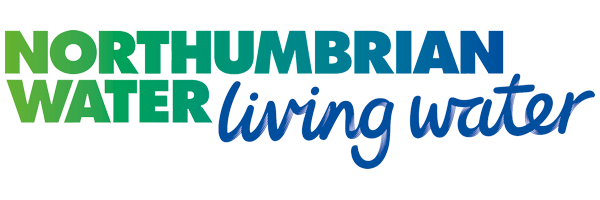Cotherstone Pipe Bridge & Mains Refurbishment (2019)
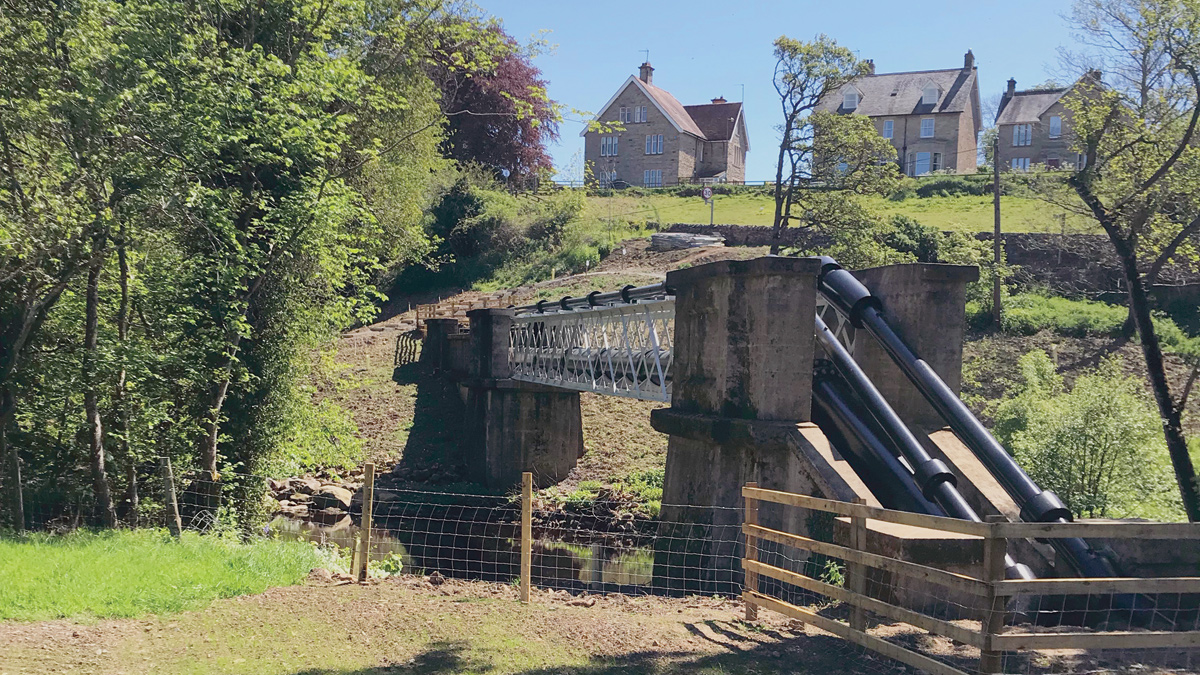
View of completed bridge refurbishment looking south-east - Courtesy of Northumbrian Water
Balder Pipe Bridge spans the River Balder in Cotherstone Village near Barnard Castle, County Durham. The bridge abutments occupy private land on either side of the bridge with a public footpath running past the south abutment. The bridge was original designed to carry a single 24” cast iron raw water main which supplies Lartington Water Treatment Works (WTW) from Grassholme Reservoir, which is capable of a supply rate of 18 MLd. The raw water is treated at the works and contributes to the supply of 75,000 commercial and domestic customers within the Teesside and Teesdale distribution areas. The bridge itself is parallel with Balder Road Bridge which carries the B6277 road running through the modestly populated (circa 600) but very picturesque Cotherstone Village.
Background
The pipe bridge was constructed in 1924 with the iron water main being cast at around about the same. The bridge does not carry a listed designation. It has steel reinforced concrete abutments but has a quite ornamental parallel chord truss arrangement span made of wrought iron with a clear span of just over 22m in length. The ironwork has been jointed using traditional riveting.
The 24” main sits on wrought iron and wooden supports, a steel strap arrangement secures the main to each support. The main enters the ground, level as it exits the bridge on the south side but a difference in levels on the North side means that the main must turn through 45° downward before entering the ground. In 1980 a 6” factory cement lined ductile iron main was added to the top level of the span secured with galvanised straps.
In 1992 an 8” potable ductile iron factory cement lined main was also added to the bridge secured using the same method. These two mains supplied potable water to Cotherstone and nearby villages.
Recent history
In 2003 the 24” main was condition assessed by Advanced Engineering Solutions Limited (AESL) as part of the Strategic Water Network Crossings condition assessment programme.
Although the bridge showed signs that it required maintenance at the time it did not show any signs of failure that would put any of the three mains at risk. Specific attention was given to the supports and strapping of the main in the location of the northern 45° bend and it was noted that it was secure.
In 2015 the 24” main failed close to the 45° bend; in affect it had lifted off its supports opening up the socket and spigot joint near to the 45° restraint. The restraint itself had not actually failed. It was immediately taken out of commission under emergency conditions and the resulting leak stopped. Although the two distribution mains were unaffected, the loss of the 24” line decreased the supply of raw water into Lartington WTW. The resulting shortfall in treated water output from the works had to be subsidised by providing 11 MLd from Broken Scar WTW in Darlington. This arrangement was deemed to be temporarily sustainable but the business made a decision that this was not the long term solution and the 24” water main would have to be repaired and brought back online. In 2017 an investigate and define study was launched to provide options.
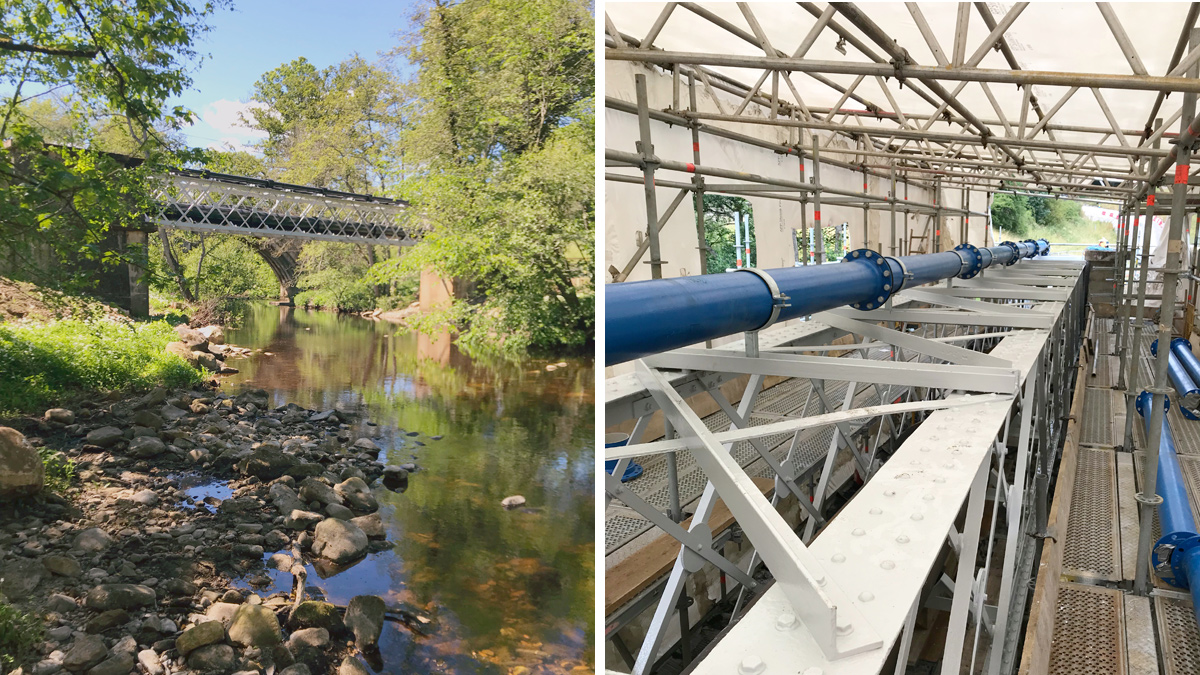
(left) View from north showing completed pipe bridge and Balder Bridge and (right) work progressing within the encapsulated structure – Courtesy of Northumbrian Water
Investigate and define study
The first stage of the study involved the full condition assessment of the pipe and pipe bridge and was carried out by AESL. On completion of the study the recommendation was made to renew the raw water main along the length of the span. The bridge itself was identified as having in the region of three years of structural integrity before failure and would require substantial metalwork repairs although the bridge abutments were in good condition.
Mott McDonald Bentley (MMB) were tasked with establishing a notional solution for the renewal of the main and the bridge refurbishment to complete the remainder of the Investigate and Define study. It was established that the solution would involve the removal and renewal of the two distribution mains, the renewal of the 24” raw water main and the refurbishment of the bridge span. The quantity of the repairs to the span was determined through a full structural survey facilitated by a two level scaffold system provided by Interlink Scaffold Limited (ISL).
On agreement of the notional solution a design and construct contract was awarded to MMB under an Engineering and Construction Contract (ECC) option C form of contract.
Site set up
The site set up was particularly challenging, with access taken on the south side via a widened field entrance and a constructed haul road to the compound. Access to the north side was more problematic and with no direct access to the abutment, an old river ford had to be re-established to allow access from the south side through the river. Trees surrounding the abutments were removed by Premier Tree Services (PTS) and a replanting schedule agreed with the local authority and private land owner.
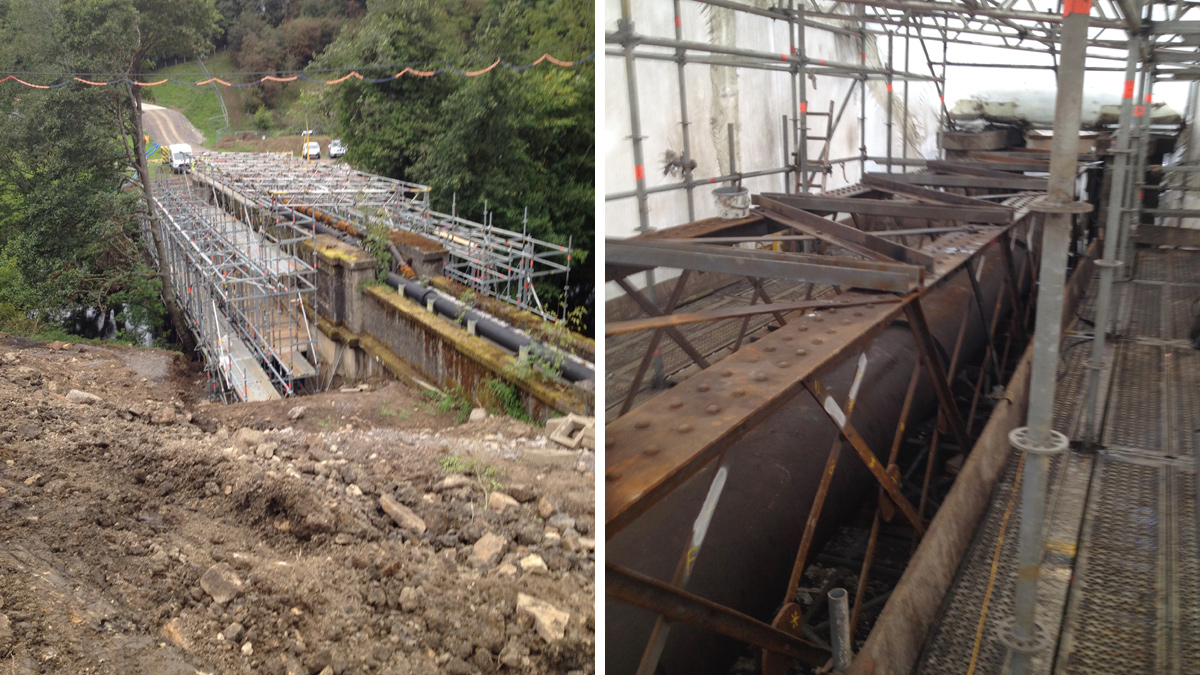
Work progressing within the encapsulated structure – Courtesy of Northumbrian Water
Old mains removal
Before any work could commence on the bridge span, the two distribution mains had to be removed. To do this two temporary 180mm high performance polyethylene (HPPE) mains were laid on the lower level of the bridge scaffold and made live through the use of line stops to avoid any interruptions to customer supplies. The line stops were provided and fitted by UTS Engineering Limited (UTS), with three being used as a buried valve was discovered on the 8” pipe that could be utilised. The use of this valve provided one of the first efficiencies of the project.
Once the two smaller mains were removed, the site team cut the decommissioned 24” at the south side. The site team cleared the bridge span of all loose debris and fully encapsulated the bridge with thick polyethylene in preparation for grit blasting. The grit blasting of the bridge was carried out by ISL. The encapsulation allowed the work to be carried out in all weathers and prevented any grit or other materials dropping into the river below.
Although not individually listed as a Site of Specific Scientific Interest (SSSI), the bridge occupies a particularly picturesque location which provides a habitat for diverse wildlife species. The grit blasting and clean was completed without any issues and once completed, it was clear that the repairs identified in the structural survey were justified. There was a slight delay in progress when severe snowfall in the county restricted many access roads.
Cotherstone Pipe Bridge & Mains Refurbishment: Supply chain
- Principal contractor: Mott McDonald Bentley (MMB)
- Survey/condition assessment: Advanced Engineering Solutions Ltd
- Scaffold & grit blasting: Interlink Scaffold Ltd
- Tree removal & replanting: Premier Tree Services
- Underpressure tees/linestops: UTS Engineering Ltd
- Traffic management: Premier Traffic Management
- Mains testing and chlorination: ARM Pipetek
- Bridge metalwork repairs/painting: Deritend
- Landscaping: WL Straughan & Sons
Metalwork repairs
The metalwork repairs were carried out by Deritend with new steel. Once cut out, the failing sections were easily replaced but traditional riveting was not practicable so bolts were used as an alternative. There was a challenge around lateral and chord section replacement at the abutments. The metalwork was boxed in on three sides at this location. The area was tight to work in, but the problem was resolved by removing the full side top and bottom in sections rather than attempting to replace in one go.
Colour matching and painting
The colour of the original bridge had not been recorded and the discolouration on the span through rusting made it impossible to determine the colour. When the abutment sections were removed it could clearly be seen that the original paint had survived within this area as the abutment walls had provided protection from the elements. The project team were able to provide a RAL code match for the silvery grey colour so the bridge span could be brought back to its original colour.
The metalwork was painted with a three-coat aluminium grade epoxy (Interseal®) and polyurethane coating system (Interthane®). During the repairs the 24” raw water main was lowered back onto its supports on the south side of the bridge with new steel straps along the whole length to secure it. The pipe was also painted in a standard black colour and was jet washed internally by ARM Pipetek in preparation for its use as a host for the new HPPE raw water main.
Reconnection
The new section of 558mm HPPE was inserted through the existing cast iron 24”main. The new main was pressure tested and reconnected to the cast iron at both sides of the bridge. Water quality sampling was not required for this section as it carries raw pre-treated water.
The two distribution mains were renewed with ductile iron and connected to either side of the upper level of the bridge span with new restraining brackets. Both sections were pressure tested and chlorinated in line with Northumbrian Water’s disinfection code of practice.
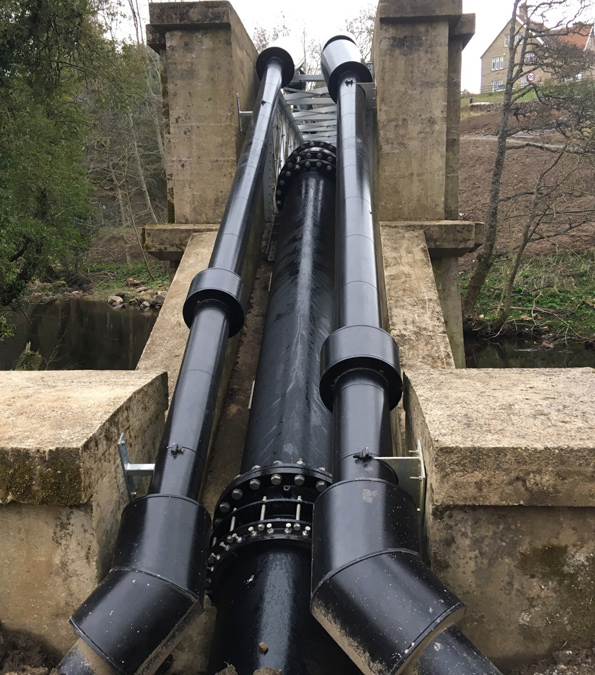
View of north abutment and completed pipework – Courtesy of NWL
Once these two sections of potable water mains had passed all water quality samples they were reconnected to the live network on both sides of the bridge without any disruption to local network supplies by utilising line stops. Both sections were wrapped in Denso Ultraseal tape and painted standard black to match the 24” raw water main. The two temporary 180mm HPPE mains could then be removed.
The three mains were brought back on line in November 2018. There were some minor issues with the new connection point for the 24” main and a slight redesign and alignment adjustment was required which resolved the problem.
Landscaping was carried out by WL Straughan & Sons (WLS) and tree replanting was carried out by PTS. The landowner requested a change in species for replanting to allow a better view of the bridge and the public footpath route once the new trees had matured.
A close relationship was maintained with the residents of Cotherstone throughout the life cycle of the project. A new bespoke play hut was commissioned from a local carpenter in the style of nearby Barnard Castle for the local primary school. Maintenance to the school yard was also carried out by the project team. A Christmas tree for the village square was provided for the festive season. Where possible local services and materials were sourced.
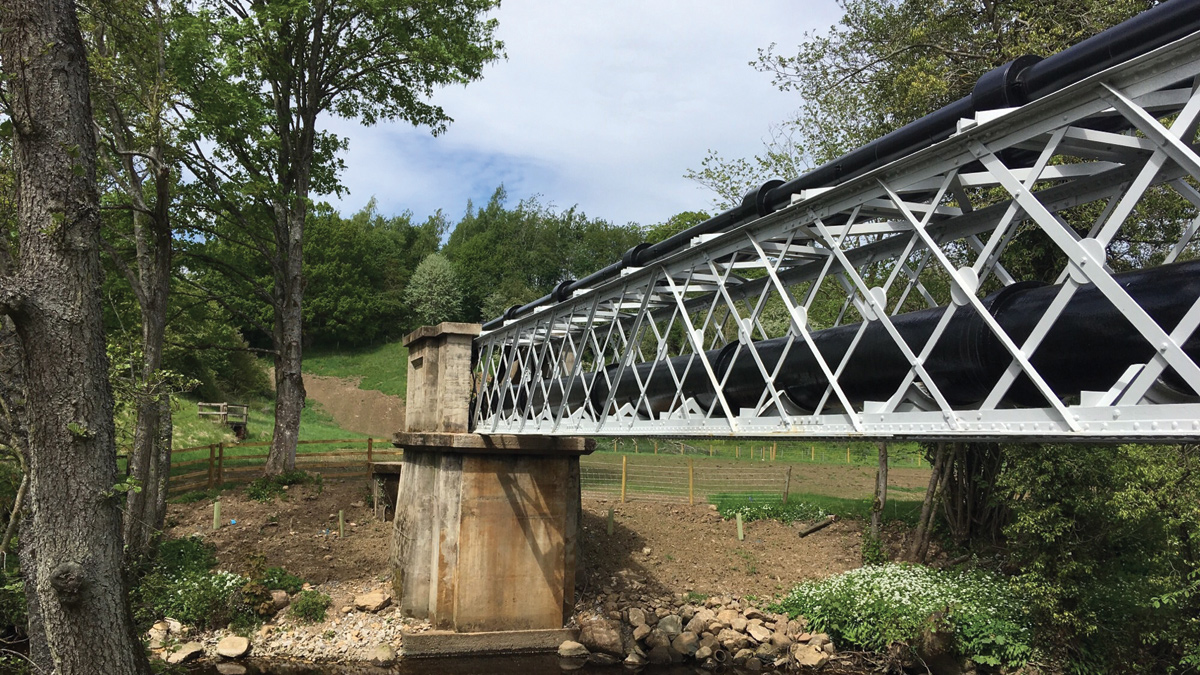
Completed pipe bridge – Courtesy of Northumbrian Waterr
The project team also installed a set of steps on a public footpath which crosses the site near the south side abutment these were completed by WLS. The steps made access to the public footpath safer and offered excellent views of the bridge.
Efficiencies were achieved throughout the life cycle of the project and varied from the reuse of the access road temporary stone to the relocation of the temporary main to take advantage of the existing previously lost apparatus. Network remodelling of the two temporary distribution mains also identified a material and operational saving through downsizing.
The overall scheme was delivered for just over £800k and is currently (May 2019) at the post project review stage.


